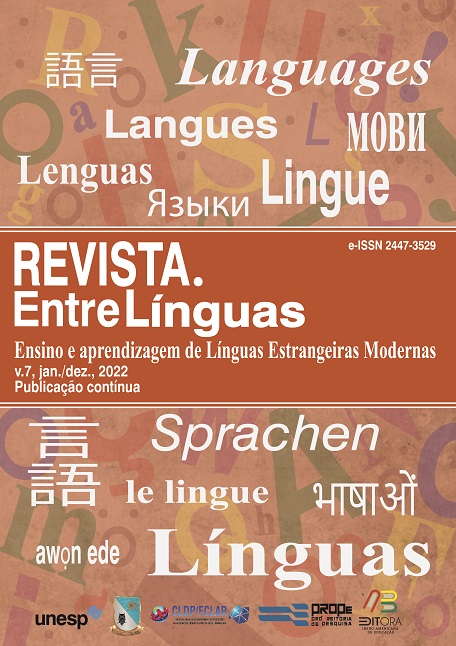¿Cómo fue abandonado el lenguaje común de comunicación en el mundo turco?
DOI:
https://doi.org/10.29051/el.v8i00.17679Palabras clave:
Rusia zarista, Repúblicas turcas, Alfabeto cirílicoResumen
Las comunidades turcas que viven en varias geografías del mundo han jugado un papel importante en cada período de la historia. A mediados del siglo X, el establecimiento del estado Karakhanid y su período islámico iniciaron una nueva era para los turcos. Influenciados por esta civilización, utilizaron el alfabeto árabe hasta el primer cuarto del siglo XIX. Los turcos rusos del siglo XX tuvieron malos resultados. De acuerdo con la "Política de Nacionalidades", los soviéticos dividieron la geografía en la URSS. Stalin implementó la política de la Rusia zarista para disolver las comunidades turcas más rápidamente y abolió el alfabeto árabe utilizado por los turcos con las decisiones tomadas en el Congreso Turco de Bakú de 1926. Después de eso, en 1928, Turquía cambió el alfabeto y obtuvo el mismo alfabeto. Se reviviría la unidad cultural entre los turcos, pero Moscú dudaba. Sin perder tiempo, la URSS trajo el alfabeto cirílico y, en última instancia, la nueva generación cortó el contacto entre sí.
Descargas
Citas
AGHAMALIOGHLU, S. Written Language and Culture of the East. Baku: VSK. NTA New Turkish Alphabet Soviet Central Committee, 1928. v. 1.
BABAYEV, A. The Open and Hidden Sides of the First Turkology Congress. Azerbaijan: University of Languages Publications, 2016.
BAKU TURKOLOGY CONGRESS. Ankara: Turkish Language Association Publications, 2008.
BAYRAMOVA, A. The New Beginning of the Science of Turkology in the XX Century: I. Baku Turkology Congress, Azerbaijan Journal of History and Methodology, v. 3, p. 12-15, 2016.
BURAN, A. Soviet Turkology and First Turkology Congress, Turkish Studies International Periodical for the Languages, Literature and History of Turkish or Turkic, v. 4/3, p. 23, 2009.
BURAN, A. Bulleted Turkology. Ankara: Akçağ Publications, 2010.
CHAQUERI, C. First Congress of Eastern Peoples. England: Cambridge University Press International Journal of Middle East Studies, v. 26, n. 4, p. 711, Nov. 1994.
DEMIREL, O. F. I. In: TURKOLOGY CONGRESS, Ankara, 1992. Proceedings […]. Ankara: Turkish Historical Society Publications, 1999.
DEVLET, N. Opening Speech of the International Symposium on Contemporary Turkish Alphabets. Istanbul: Marmara University Publications, n. 509, 1992.
FIRST TURCOLOGY CONGRESS. Report 26 February-5 March 1926,1. bs. Azerbaijan: Ministry of Culture and Tourism Publications, 1926
FIRST TURKOLOGY CONGRESS REPORT MINUTES. 26 February-5 March 1926. 1. ed. Azerbaijan: Ministry of Culture and Tourism Publications, 2011.
GALANTI, A. Arabic Letters Do Not Prevent Our Progress. Istanbul: Bedir Publishing House, 1996.
GASOMOVA, B. “Historical Development Process of the Azerbaijani Alphabet Azerbaijan Press in the Transition Process from the Arabic Alphabet to the Latin Alphabet (New Way, New Idea, Işık Yol)”. Turkish World Journal of Language and Literature, v. 51, p. 39-40, Spring, 2021.
HÜRREMKIZI, A. The Participation of Turkic Peoples and the Issue of Elifba in the Turkology Congress. Azerbaijan: National Academy of Sciences, 2016.
KAZIMOGHLU, M. The Invisible Side of the First Turkology Congress. Azerbaijan: National Academy of Sciences, 2016.
KHOJAYEV, K. S. My Old Memories and Emotions on New Elifba Ways. Baku: Manuscripts Department No: 496-362-81, 1929.
KILICH, R. Educational Issues in Turkey and Turkish Republics. Available: http://host.nigde.edu.tr/remzikilic/makale/index.php?entry=entry091114-201135. Access: 02 June 2020.
KOLTUK, N. Azerbaijan in Ottoman Documents. Istanbul: TDBB Publications, 2015.
NERIMANOGHLU, K. V. 1926 Baku Turkology Congress. Baku: Chinar, 2006.
NESIROVA, A. Latin Alphabet Stages in Azerbaijan. Azerbaijan: Ministry of Education Publications, 2019.
ORDBADY, M. S. Yeni Yol Newspaper, 07.12.1927. Azerbaijan Archive. Place No: 26452. p. 34. 1927.
OTTOMAN STATE ARCHIVE. Archive 30-18-1-1 / Department of Decisions (1920-1928) Location: 17-91-9.
POLIVANOV, E. D. “One of the Theorists of Soviet Language Policy A. Sh.Bikkulova”, Journal of Young Science, v.12, p. 219, 2011.
SARAY, M. Language and Culture Union in the Turkish World. Ankara: Turkish Language Association Publications. 2008.
SHERIFOGHLU, O. Defense of Islamic Letters. Istanbul: Sebil Publishing. 1997.
SHIMSHIR, B. N. History of Turkish Alphabet in Azerbaijan. Ankara: Turkish Historical Society Publications. 1991.
TACEMEN, A. Changing the Alphabets of the Turks under Russian Rule, (1769-1940). Kayseri: Erciyes University Publications, n. 68, 1994.
TOKER, M. Khalid Who Played a Major Role in Turkistan's Transition to the Latin Alphabet Seid Hodjayev and New Elifba Roads Old Memories and My Feelings. In: TURKOLOGY CONGRESS, Ankara, 1996. Proceedings […]. Ankara: Turkish Historical Society Publications, 1999.
TOYNBEE, A. J. The adoption of the Latin in place of the Arabic alphabet in Turkey and in the Turkish States Members. London: Oxford University Amen House, 1929.
TURKMEN, F. Common Alphabet Language Transition to Latin alphabet in Kazakhstan, Uzbekistan, Azerbaijan. New Turkey, v. 101, p. 318-319, May/June, 2018.
WHITE, S. Communism and the East: The Baku Congress, 1920. England: Cambridge University, 1974.
YENI YOL NEWSPAPER. Azerbaijan Manuscripts Department. Place No: 07 (49-924) J-56,1927.
YESILYURT, Z. Russification Policy in the Soviets and Murdered Intellectuals. Turkish Culture, v. 165, p. 562, 1976.
Publicado
Cómo citar
Número
Sección
Licencia

Esta obra está bajo una licencia internacional Creative Commons Atribución-NoComercial-CompartirIgual 4.0.
Os manuscritos aceitos e publicados são de propriedade da Revista EntreLínguas. Os artigos publicados e as referências citadas na Revista EntreLínguas são de inteira responsabilidade de seus autores.
Transferência de direitos autorais – autorização para publicação
Caso o artigo submetido seja aprovado para publicação, já fica acordado que o(s) autor(es) autoriza(m) a UNESP a reproduzi-lo e publicá-lo na EntreLínguas, entendendo-se os termos “reprodução” e “publicação” conforme definição respectivamente dos incisos VI e I do artigo 5° da Lei 9610/98. O artigo poderá ser acessado pela rede mundial de computadores (Internet), sendo permitidas, a título gratuito, a consulta e a reprodução de exemplar do artigo para uso próprio de quem a consulta, desde que haja a citação ao texto consultado. Essa autorização de publicação 328 EntreLínguas, Araraquara, v. 1, n .2, p. 323-328, jul./dez. 2015 não tem limitação de tempo, ficando a UNESP responsável pela manutenção da identificação do(s) autor(es) do artigo. Os artigos publicados e as referências citadas na Revista EntreLínguas são de inteira responsabilidade de seus autores.











